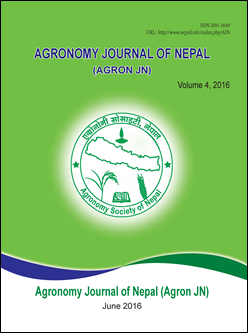Response Differences Stability Model Simplify the Identification of Stable Rice Genotypes for Low Temperature Environment
DOI:
https://doi.org/10.3126/ajn.v4i0.15512Keywords:
Low temperature, REDIS, Rice genotype, Response difference stabilityAbstract
Stable genotype is necessary for long-term grain security to the farmers. Developing site specific variety is a good way of maintaining diversity and getting potential yield. Simple parameters were estimated based on nine rice genotypes evaluated under low temperature at three different altitudinal environments of Jumla, Lumle and Khumaltar. The genotypes were influenced by the varying conditions and G x E interaction which was highly significant for maturity, bearing tiller, and plant height and grain yield indicating responses of the rice genotype in different environments. These traits are very important for adoption of genotypes in farmers’ field. It can be inferred that there is a possibility of developing site-specific variety which are stable and adoptable across these environments. Cold environment rice genotypes of NR10288-015J-15J-7, Chhommrong and NR10293 are most stable and ideally adapted in cold stress environment. NR 10346 is the site-specific genotype adapted to favorable environments. Hence, these genotypes could be used in breeding programs for increasing the productivity of rice in cold environment and for general cultivation as well.
Agronomy Journal of Nepal (Agron JN) vol. 4, Page: 1-8, 2016
Downloads
Downloads
Published
How to Cite
Issue
Section
License
ASON permits for free use, distribution and reproduction in any medium if the original work is properly cited and not used for commercial purposes.




